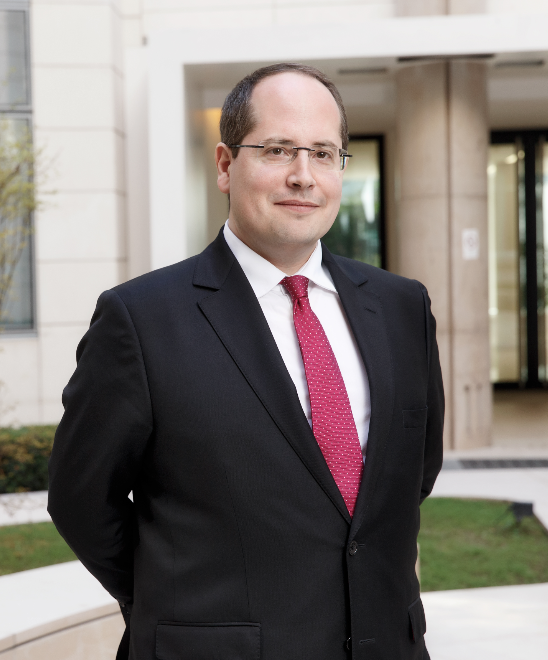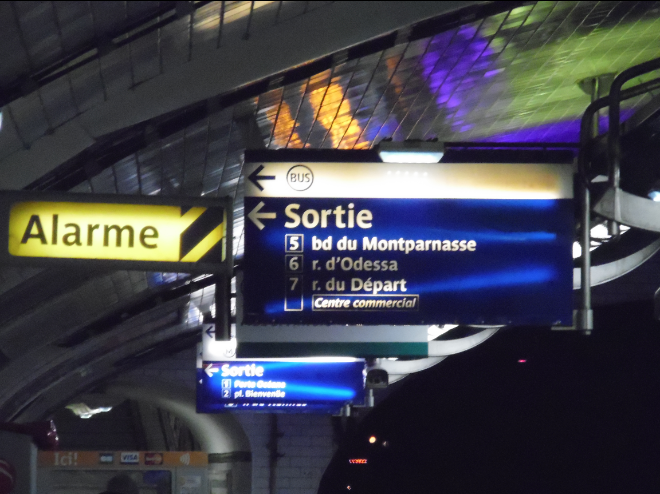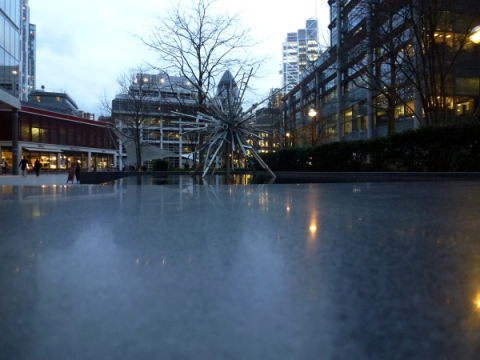—
“You don’t have to be afraid of sharing with your supervisor your major risks. I think the worst case for a supervisor is having an undertaking not aware of their exposure and main weaknesses. If we know that you are aware then we are much more confident in your management actions.”
At the time it didn’t seem like it, but that message, that it is ok for insurers to show the regulator they have some vulnerabilities that they are aware of, has emerged as the overarching theme of the French Regulator’s view of the ORSA.
 Romain Paserot, directeur des affaires internationales, head of Solvency II Project (and until recently director of insurance supervision) at the Autorité de contrôle prudentiel et de résolution (ACPR, the French regulatory authority), tells me this in his office.
Romain Paserot, directeur des affaires internationales, head of Solvency II Project (and until recently director of insurance supervision) at the Autorité de contrôle prudentiel et de résolution (ACPR, the French regulatory authority), tells me this in his office.
We are meeting two weeks before the submission of the second ORSA exercise by over 400 French insurers is due. The ACPR went beyond the requirements of the Interim Guidelines and asked insurers to provide all three assessments of the ORSA.
As I sit at a round table, staring out of the window of the fifth floor at a rooftop garden in the adjacent building, I am unsure what I will do with the information he will provide me over the next hour. I tell him that it’s not clear in my mind if this will be a basis for drafting a comment article or a feature interview. He is OK with that. For now I want to understand what he and the ACPR think about the ORSA and how the French insurance industry is managing with this very new concept.
He tells me that in last year’s ORSA reporting exercise they saw “too much of a sort of pro domo plaidoyer for the supervisor’s eyes about the quality of the management and the risk management of the undertaking.” He says it so matter-of-factly I feel I must nod as if I understand what the expression means. Essentially it means that the ORSA was too much of a compliance exercise demonstrating that all was well externally. “So it was pro domo plaidoyer for the supervisor and not an internal process leading to an own report,” he says.
“I really want the industry to understand that the ORSA is not a costly external requirement but has a huge benefit for them. It has indeed to be sent to the supervisor, but the primary objective is for them to have a full review of their own risks based on their own process with the level that is good for their own needs to make good decisions.”
Focus on risks

The thing you notice most about Paris is the light. It has a special quality. Even in September it is stronger than the British summer sunlight. Not stronger, more full-bodied. Not as intense as the Spanish sunlight, but when you ponder this more deeply, as I did when I walked down rue Taitbout to number 61, the ACPR’s shiny new building, it makes sense that impressionism originated in France. There is something about the light. As I write I can recount the shadows on the buildings and the splatter of light on the road.
The front of the building is obscured by scaffolding and the bustle of workmen shovelling, carrying and generally being builders. I walk through a passage of steel poles and wood panes under the scaffolding, through a secure revolving door into the very modern, very airy, entrance hall of the ACPR with its five-storey glass wall looking onto a garden and a café in an inner courtyard. As I sit and wait to be escorted in I notice some of the greenery overhanging from the rooftop garden.
“What we are assessing is not only the fact that you know your current risks but that you are equipped with something that will give us confidence that you are able to detect new or emerging risks and to address them adequately.”
Mr Paserot’s remark is a response to the fact that many of the ORSA’s submitted last year were overly detailed and cluttered with irrelevant information.
“We want to have the ORSA focused. So we don’t want to have something like students sometimes do for an exam when they put a lot of details and expecting that they get some points or a mark at the end. So you say my teacher will be very happy if I put a lot of things. No, it is very important to be focused.”
He smiles when he talks about making the teacher happy, which I think threw us both to our school days for a split second. But the analogy makes the point, as many of the ORSAs examined by the ACPR included very lengthy ORSA documents including extensive lists of risks, which, Mr Paserot explains, not only defeats the purpose of the ORSA but is also an indication of a lack of understanding of the insurer’s own risks.
“The capacity of focusing on what is very important is something that we assess in the benchmarking of the ORSA. The ability to select what is essential and justify this selection is meaningful… So one of the decisions we assess is your capacity to say this is essential and I will address that in the ORSA and this is less essential and I will not put that in the ORSA.”
“What we say is that we don’t expect to see a full list of risks, but your main risks. So it means you have to make a judgment of what is important. So obviously we don’t want to have the same ORSA for very big undertakings and different risk as for small undertakings.”
“For instance, some people say can you provide us with a list of risks that we have to address in the ORSA? This is simply the opposite of the purpose of the ORSA. So we are not going to give guidance because we want to keep the freeform exercise.”
Article 45 (1) (b) on-going compliance with the capital and technical provisions requirements

The central figure in Le déjeuner sur l’herbe stares at you on the fifth level of the Musée d’Orsay. The old railway station that was converted into a museum houses some of the impressionist genre’s seminal works. Le déjeuner sur l’herbe was painted by Édouard Manet in 1863. It was one of the first works to be painted outdoors and caused an outrage with its bold subject and disregard for many of the artistic and aesthetic conventions of the time. As the museum’s own commentary explains: “Le déjeuner sur l’herbe – testimony to Manet’s refusal to conform to convention and his initiation of a new freedom from traditional subjects and modes of representation – can perhaps be considered as the departure point for Modern Art.”
Wandering around the museum I encountered another departure … a departure from common sense. It is the bewildering phenomenon of taking a selfie or having your photo taken with a famous work of art. Sure I’m familiar with the idiotic practice of hordes of tourists rambling through museums taking pictures of the stuff on the walls (pssst … for a fiver I’ll tell you about this place where you can get all these photos – its called the internet). But the selfie with famous artworks or SWFA (pronounced swee-fa) takes the practice to a new level.
It is as if these paintings have become objects, or landmarks, that one somehow leaves one’s own mark on by having your photo taken with them. It gives art a whole new personalised and commoditised meaning. There I am by the Eiffel Tower, here’s one of me at the Arc de Triumph, and here I am at the (or is it ‘with the’?) Poppy Field by Claude Monet or Vincent Van Gogh’s Portrait de l’artiste; hmmm … I don’t like it so much, why is he so sad? Maybe a photo with the (or is it, ‘at the’?) Le café Campana.
Amid the ORSA talk about the freeform exercise and ‘Own’ (remember the mantra: the ‘O’ in ORSA stands for Own) it is easy to forget that the ORSA does have some set requirements. The industry in France (and elsewhere) is struggling with two of these in particular. The first is the need to demonstrate compliance on a continuous basis with the capital and technical provisions requirements (Article 45 (1) (b)). We will get Article 45 (1) (c) later.
“The objective is quite clear,” Mr Paserot says. “How confident are you that you won’t have a breach of your quantitative requirements in the future. So it means that it is not about looking only at the past and saying I have covered my SCR by two times in the past so it’s ok for me. You have to think about what could jeopardise your ability to meet your commitments in the future. This question is really about in which situations will I be in danger of what?”
 A common mistake made by many undertakings in the first ORSA submission was to examine a number of stress scenarios under which they did not breach the SCR. While this was useful it misses the point.
A common mistake made by many undertakings in the first ORSA submission was to examine a number of stress scenarios under which they did not breach the SCR. While this was useful it misses the point.
“You don’t learn much by looking at a few stress scenarios that don’t bite you … You really should go beyond that and say I will try to build a scenario where I am sure its not going to work anymore and look at that. And then you assess the probability of that scenario.”
“So it is very important to see what could bring you to your knees or not. I think that is an intellectual work that is very important because looking at that you can say well the probability is low but still I can take some actions that make sure that even if these scenarios happen I am not in this [negative] situation.”
Essentially this is a form of reverse stress testing, I point out.
“Yes, and I think that there is a value of doing that. There has been a lot of discussion with industry saying: ‘my scenario has to be based on my commercial planning and development planning and things like that’. And yes obviously it is important that this vision of your continuity of compliance has to be in line with your business plans that is for sure… But the question is not having full details of your business plan, but to think, I would say, of a range of situations and see what’s going to happen to your solvency in a range of situations. And that is very important.”
Mr Paserot leans forward a little in his tall black chair and thumps the table lightly with his finger as he turns the argument on its head. He points out that asking in what situations the insurer is unable to meet its commitments is a basic business principle that management should look at even if there was no ORSA.
“But still we could ask the question in the other way. I mean it is probably the question that every board has addressed of themselves since the beginning of insurance; even if there was no ORSA requirement. If I were a member of a board, a chairman of a board, I would look carefully not only to my business case, but also in which situation would I have a problem to meet my commitments and the requirements of the regulation. It would be one of my first questions. It is a very important question.”
“Its really about the life or death of the undertaking. So that is a question that you cannot skip even if the regulation does not ask you to do that. Obviously you can put different levels of complexity in the way you are modelling your future. You can do a very complicated approach or a very simple approach and you will probably have to enhance the approach over time. But still I think that’s a question that you will have to address anyway.”
Introducing standardised stresses
Ever seen Paris through a glass of wine? It looks like this.

In a move that may be regarded by some as going against the ‘O’ spirit of the ORSA, the French regulator introduced a number of standardised stresses for assessing continuous compliance with the capital requirement in the ORSA submission this year. One of the reasons for introducing standardisation in the preparatory phase has been the current economic environment and the different approaches insurers are taking to model them.
“Since the question of the low yield environment is very important we think it will be useful to give a few scenarios that will be used by every undertaking and so we have the ability to aggregate the results,” Mr Paserot explained.
Article 45 (1) (c) significant deviation from the assumptions of the standard formula

Many of the gems of Paris can be found away from the city centre, but not all of them are hidden. Some are easy to find and accessible to all; like diamonds strewn on the ground in a field: all you have to do is reach out and collect them. One such gem is the Fondation Cartier pour l’art contemporain, easily accessible along the Boulevard Raspail. From the street you could mistake the massive glass structure nestled in the greenery to be a university or a science centre. It’s as if the phrase ‘tucked away’ was invented to describe how this glass construction fits into the semi-suburban cityscape of the 14th arrondissement.
At the time of my visit it features a ninety-year retrospective of contemporary art of the Democratic Republic of the Congo: ‘Beauté Congo – 1926-2015 – Congo Kitoko’. I am struck by how contemporary the art is for each period. There is an almost anthropological naivety to the works of the 1930s depicting scenes of wildlife and rural living. As the exhibition progresses in time the art transforms to echo the zeitgeist. There is a display of magnificent models of futuristic cities reminiscent of space cartoons from the USA in the 1950s and 60s, and of course a rendition of Muhamad Ali’s epic ‘rumble in the jungle’ with George Forman. The art and the messages become increasingly political as they dissect life in Kinshasa and the meaning of Africa’s place in the world today. The paintings scream gangsta-rap at you with their shiny commercial plastic slickness of the imagery, every bit as dazzling and intimidating as the music itself.
We are back … to Article 45 (1) (c) of the Solvency II Directive, which is all about the undertaking’s ability to assess significant deviation of its risks from the assumptions underlying the calculation of the Standard Formula.
There are five prescribed risk modules in the Standard Formula, which are used to calculate the SCR. Undertakings must use the ORSA to capture and evaluate any gaps between their own risk profile and the regulatory requirement. The assessment is made all the more difficult given that the modules of the standard formula are set to be reviewed by the end of 2018.
Mr Paserot explains that the purpose of the assessment is not to have a sort of “standard formula bashing per se”, but rather that the SCR calculation should be viewed critically and in context.
“You have to look at the results of the standard formula … and say: do we, as people knowing our risk and having a view of our undertaking at the time, think that the result of the standard formula is an adequate measure of our losses in a one-year time horizon at a level of confidence of 99.5%?”
“You have to have a view on your loss distribution,” he explains.
Taking a view should apply to undertakings of all sizes and complexity. “You can do a very tailor-made approach and that is what those doing an internal model are doing. They say I have a view on that [that is] much more adequate to my risk profile. But even for a simple organism [he uses the French word for organisation] you can look at that and the results and see that it’s good or it’s not good for whatever reason. For the reason they want to assess.”
He accepts that the standard formula is a complicated calculation and believes that it will take insurers time to assess its appropriateness for capturing their own risks. “Obviously you will learn by doing. Because the standard formula is quite a complicated calculation, with non-linear and aggregation effects. So obviously you will learn over time what the results are and if you think for instance that the volatility of the standards formula calculation is adequate to your real volatility of your risk that is something you can discuss over time.”
Conflicted endings
You wouldn’t ordinarily think of the Metro as a landmark. My new camera thinks otherwise. Everything looks so shiny. So crisp.

Our interview tapers to an end. Sometimes that’s when people tell you the most important stuff. It’s not by design, nor is it a reflection of the quality of the interview. It just happens like that. Not on this occasion. When I sat down at the round table in this very genial man’s office to discuss the ORSA I had no idea that the 2,800 words or so you have just read would turn out as they did. That also just happens like that.
My conversation with Mr Paserot, and with other regulators, leaves me with a distinct impression that there is something conflicted about the ORSA: it is your own, but it sort of isn’t. The message from the regulator is as clear as it is frustrating to industry: the ORSA is your own assessment of your risks but the regulator has a view on those risks too. And most importantly it wants you to demonstrate that you are aware of them.
—

To subscribe to the Solvency II Wire mailing list for free click here.
[adsanity_group num_ads=1 num_columns=1 group_ids=233 /]]]>








